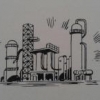Latest Downloads
-
 Water Bath Indirect Heaters
Water Bath Indirect HeatersArt Montemayor - Oct 12 2018 02:35 PM
-
 Petroleum: A Primer for Kansas
Petroleum: A Primer for KansasArt Montemayor - Oct 12 2018 02:27 PM
-
 Spray Tower for Flue Gas Scrubbing Design
Spray Tower for Flue Gas Scrubbing Designankur2061 - May 02 2018 02:31 PM
-
 Selection of Vertical Tanks
Selection of Vertical Tanksankur2061 - Apr 19 2018 07:42 AM
-
 Pressure Drop Calculator for Strainers 1
Pressure Drop Calculator for Strainers 1ankur2061 - Mar 24 2017 02:04 PM
-
 Horizontal Pig Trap System Design Guidelines
Horizontal Pig Trap System Design Guidelinesankur2061 - Jan 14 2017 02:54 PM
-
 Performance Prediction of 3-Stage Propane Refrigeration System
Performance Prediction of 3-Stage Propane Refrigeration Systemankur2061 - Aug 08 2016 02:43 PM
-
 Centrifugal Pump Troubleshooting Checklist
Centrifugal Pump Troubleshooting Checklistankur2061 - Dec 17 2015 08:18 AM
-
 Compressor Troubleshooting Checklist
Compressor Troubleshooting Checklistankur2061 - Sep 08 2015 11:43 AM
-
 Amine Sweetening Unit Preliminary Design
Amine Sweetening Unit Preliminary Designankur2061 - May 19 2015 09:35 AM
Popular Store Titles
 Tank Jacket Calculator
Tank Jacket Calculator
 Specification Sheet Collection
Specification Sheet Collection
 PIPESIZE
PIPESIZE
 Relief Valve Sizing
Relief Valve Sizing
 Rupture Disc Sizing
Rupture Disc Sizing
Chemical and Process Engineering Resources
Submitted Chris Haslego, Nov 21 2011 11:21 AM | Last updated Nov 21 2011 01:29 PM
| Category: | Heat Transfer Technology |
| Question: | For a heat exchanger, will the overall heat transfer coefficient increase along with an increase in LMTD (log mean temperature difference) around the unit? |
| Keywords: | lmtd,u-value,heat,transfer,coefficient |
| Answer: | The overall heat transfer coefficient is generally weakly dependent on temperature. As the temperatures of the fluids change, the degree to which the overall heat transfer coefficient will be affected depends on the sensitivity of the fluid's viscosity to temperature. If both fluids are water, for example, the overall heat transfer coefficient won't vary much with temperature because water's viscosity doesn't change dramatically with temperature. If, however, one of the fluids is oil which may have a viscosity of 1000 cP at 50 ??F and 5 cP at 400 ??F, then indeed the overall heat transfer coefficient would be much better at higher temperatures since the oil side would be limiting.Realize that the overall heat transfer coefficient is dictated by the local heat transfer coefficients and the wall resistances of the heat exchanger. The local heat transfer coefficients are dictated by the fluid's physical properties and the velocity of the fluid through the exchanger. So, for a given heat exchanger, fluid flow rates, and characteristics of each fluid....the area of the exchanger and the overall heat transfer coefficients are fixed (theoretically anyway....as the overall heat transfer coefficient does vary slightly along the length of the exchanger with temperature as I've noted and the U-value will decrease over time with fouling). But, if the inlet temperatures of the fluids change, the heat duty (Q) is where variable that will change with it for the most part. For example, for an installed heat exchanger, if the LMTD or log mean temperature difference increases or decreases based on temperature variations of the fluids, then a given, fixed exchanger will simply transfer more heat (for a larger LMTD) or less heat (for a small LMTD). In short, temperature difference is the "driving force" which determines how much heat is transferred. If the LMTD decreases, but you want to keep Q the same, then you have two choice: increase the heat transfer area or find a way to increase the overall heat transfer coefficient (U-value) via heat transfer enhancement or a different heat exchanger technology.Again, with an increased temperature, the viscosity of the fluids will decrease (to what degree depends on the fluids), so there would technically be an increase in the U-value, but often times, it won't be substantial. |
| Links: | Basics of Industrial Heat Transfer Correlations for Convective Heat Transfer |
Forum Quick Links
Tech Q & A Category List
-
 Bulk Solids
Bulk Solids
-
 ChE Outside the Plant
ChE Outside the Plant
-
 Chemical Process Business
Chemical Process Business
-
 Chemistry Basics
Chemistry Basics
-
 Corrosion
Corrosion
-
 Equipment Design
Equipment Design
-
 Experimentation and Testing
Experimentation and Testing
-
 Fluid Dynamics
Fluid Dynamics
-
 Heat Transfer Technology
Heat Transfer Technology
-
 Industrial Utilities
Industrial Utilities
-
 Mass Transfer
Mass Transfer
-
 Physical Property Information
Physical Property Information
-
 Plant Basics
Plant Basics
-
 Plant Economics
Plant Economics
-
 Preparing to Become an Engineer
Preparing to Become an Engineer
-
 Process Control
Process Control
-
 Reactions and Processes
Reactions and Processes
-
 Refining
Refining
-
 Safety
Safety
-
 Separation Technology
Separation Technology
-
 The Environment
The Environment
-
 Thermodynamics
Thermodynamics

 FB
FB



0 Comments